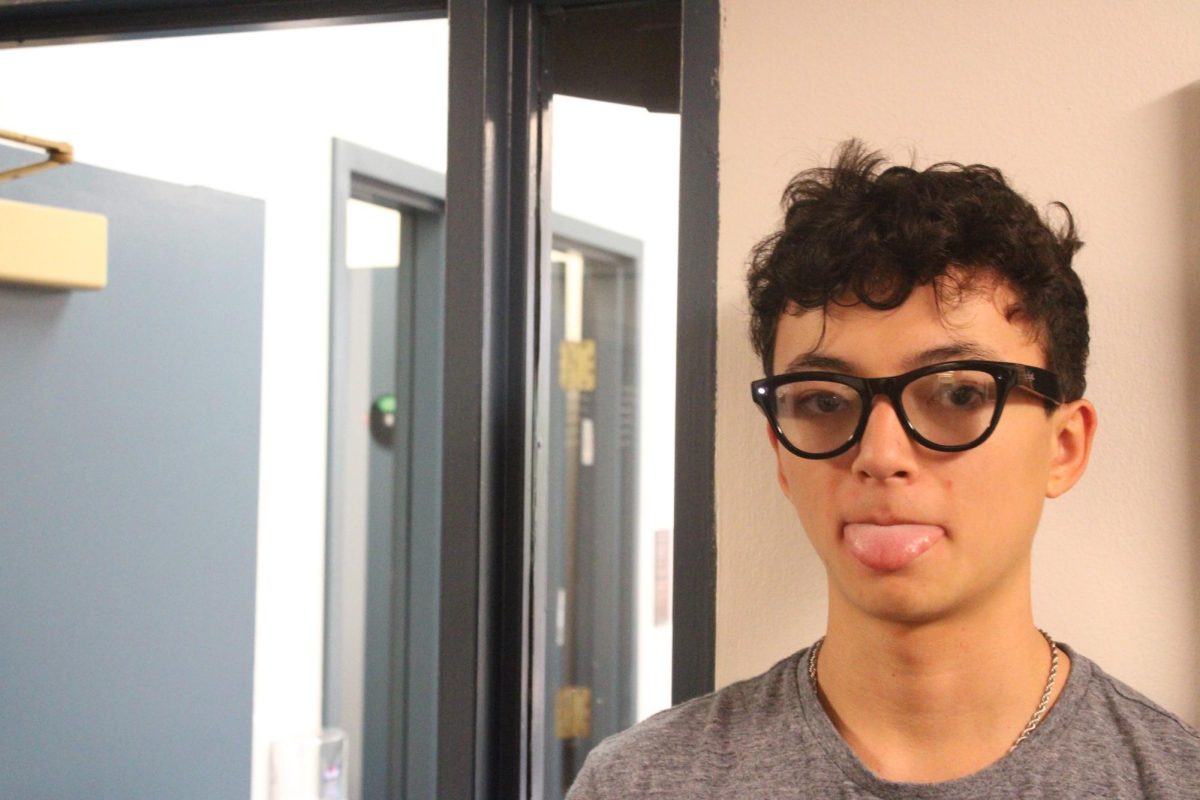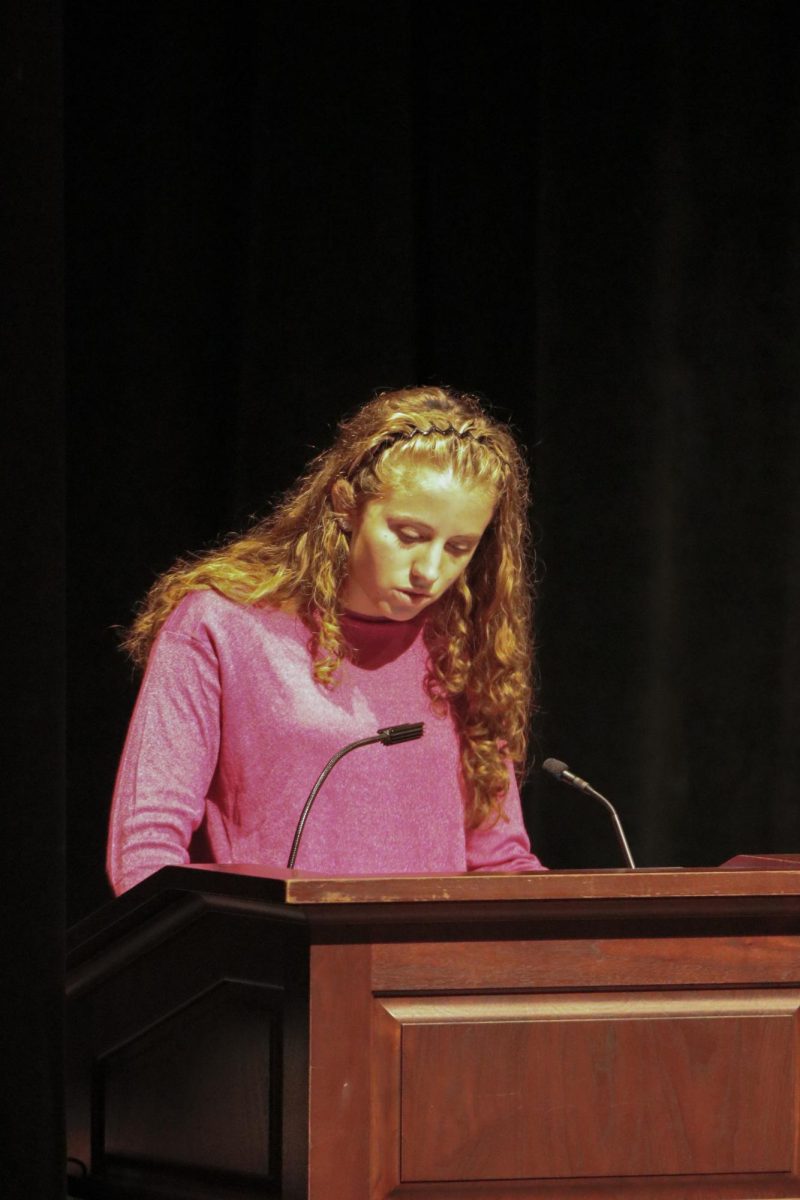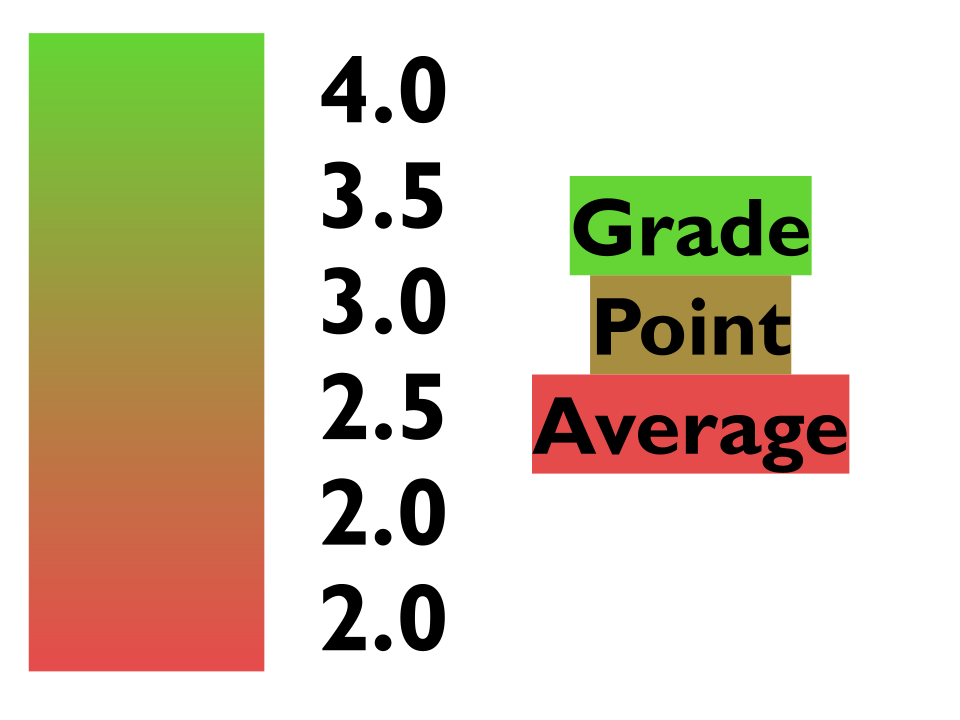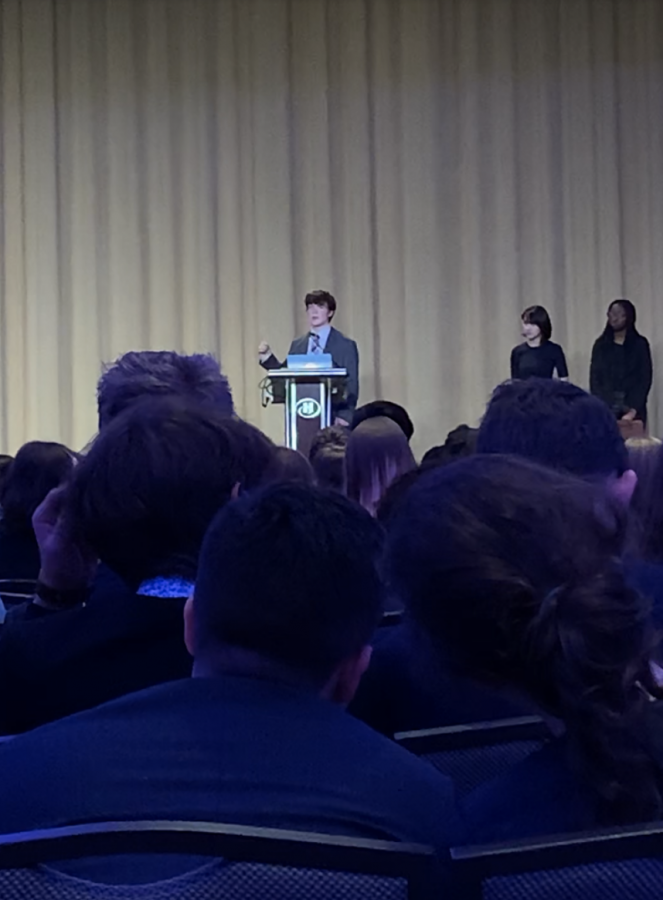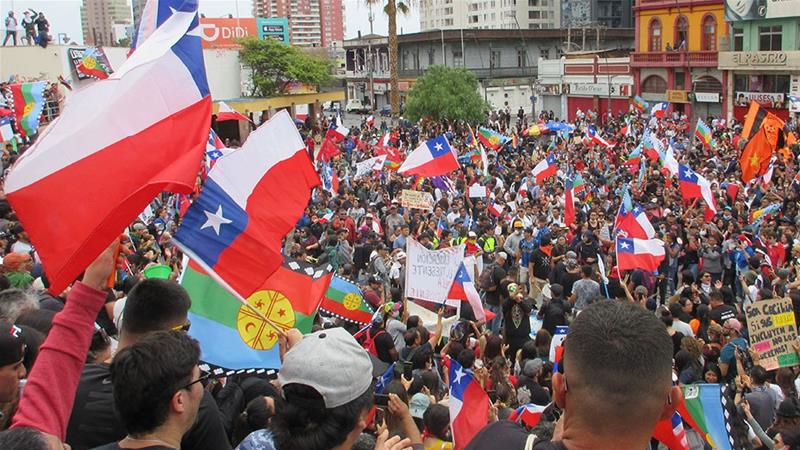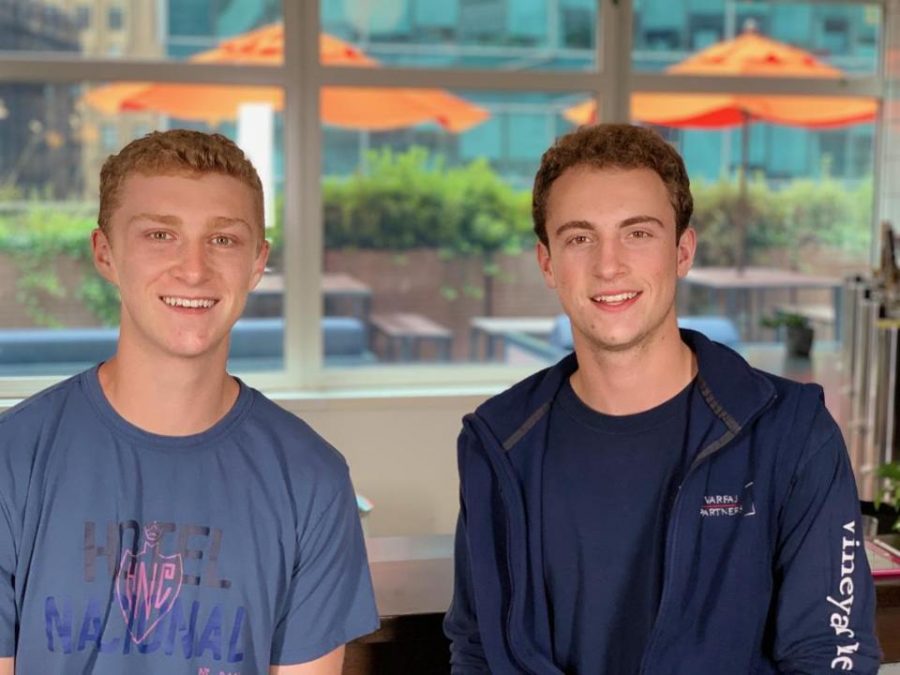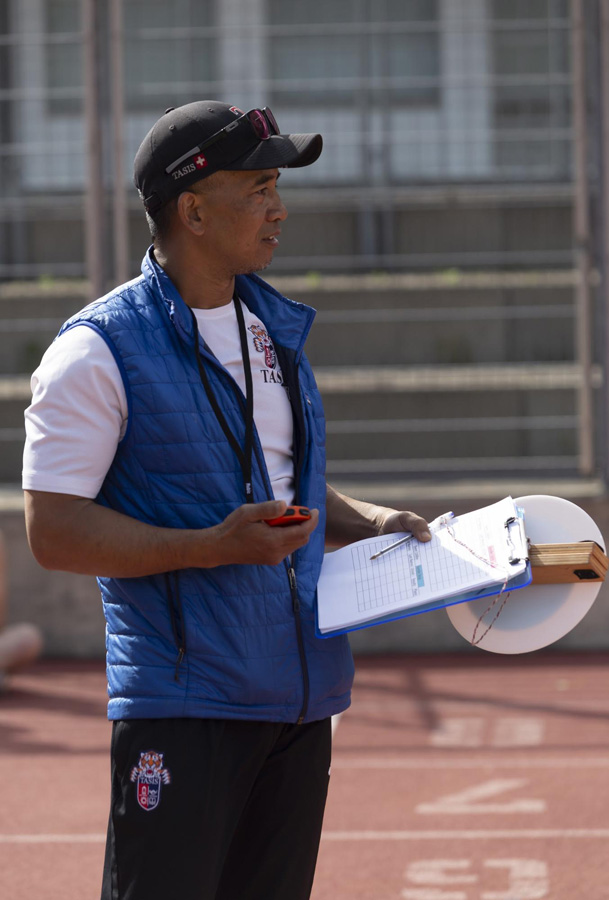Alexis Lopez
As continued from 43 Missing Students in Mexico (Part 1). Yulissa Arroyo ’15, Alexis Lopez 15′, Martina Pineiros ’15 attended a protest for the 43 missing students from Ayotzinapa, Mexico. The following is Alexis’s first-hand account of their experience, accompanied by his photography of the event.
[caption id="attachment_4594" align="alignnone" width="300"] Protesters gather and wait to start marching.[/caption]
1, 2, 3, 4… Martina, Yulissa and I stood cold and shivering at the corner of 18th St and Blue Island Ave under the giant Mexican Eagle Statue that mirrors the Angel de la Independencia in Mexico City. Just in front of the original statue, millions of Mexican protesters were heading to Mexico City’s main plaza known as El Zócalo. Back home in Chicago, 2,096 miles away, 400-500 people were gathering for the same cause, for the return of the 43 missing students from Ayotzinapa. As we waited for the protests to move, the leader of the group spoke of the terrible situation and how for the past 2 months they have not been found. A young woman next to me held a candle on her right hand and a poster of one of the students on her left. Her head hanged low praying under her breath. Her presence served as a reminder that this isn’t a violent protest or a call for a revolution, but one for reform in the corrupt political system and a vigil for these missing students.
[caption id="attachment_4590" align="alignnone" width="300"]
Protesters gather and wait to start marching.[/caption]
1, 2, 3, 4… Martina, Yulissa and I stood cold and shivering at the corner of 18th St and Blue Island Ave under the giant Mexican Eagle Statue that mirrors the Angel de la Independencia in Mexico City. Just in front of the original statue, millions of Mexican protesters were heading to Mexico City’s main plaza known as El Zócalo. Back home in Chicago, 2,096 miles away, 400-500 people were gathering for the same cause, for the return of the 43 missing students from Ayotzinapa. As we waited for the protests to move, the leader of the group spoke of the terrible situation and how for the past 2 months they have not been found. A young woman next to me held a candle on her right hand and a poster of one of the students on her left. Her head hanged low praying under her breath. Her presence served as a reminder that this isn’t a violent protest or a call for a revolution, but one for reform in the corrupt political system and a vigil for these missing students.
[caption id="attachment_4590" align="alignnone" width="300"] Some of the students’ faces on the protesters banner.[/caption]
10, 11, 12, 13… We walked and chanted down Loomis St. with police officers guiding the way. In the front, drummers played to the beat of our steps and in the back a man pushed along some speakers on a cart with another man speaking to passerby’s and cars. Many people that passed by asked what we were protesting and why? What is the use of protesting when nothing is going to change? What does it matter? Especially when we are so far away from the problem. However, while I am unable to go to Ayotzinapa and join in the search or currently go to Mexico City to join the protests, I have the ability to speak and bring awareness of the disappearing here in the U.S. so in turn people can pressure their elected officials to ask questions and urge the Mexican government to find them.
[caption id="attachment_4599" align="alignnone" width="300"]
Some of the students’ faces on the protesters banner.[/caption]
10, 11, 12, 13… We walked and chanted down Loomis St. with police officers guiding the way. In the front, drummers played to the beat of our steps and in the back a man pushed along some speakers on a cart with another man speaking to passerby’s and cars. Many people that passed by asked what we were protesting and why? What is the use of protesting when nothing is going to change? What does it matter? Especially when we are so far away from the problem. However, while I am unable to go to Ayotzinapa and join in the search or currently go to Mexico City to join the protests, I have the ability to speak and bring awareness of the disappearing here in the U.S. so in turn people can pressure their elected officials to ask questions and urge the Mexican government to find them.
[caption id="attachment_4599" align="alignnone" width="300"] “¡Alto a la represión! Ayotzinapa Somos Todos. Chicago Nov. 20” written on the Mexican flag.[/caption]
18, 19, 20, 21… Something very important to understand about Mexico is the fact that the police force is widely, and almost publically, known for being corrupt and violating human rights. Upon crossing the border into Mexico there are signs posted on walls reading “ No A Las Mordidas” (“No to bribes”). These signs are posted up in an effort to fight the long standing status quo of bribing away officials, instead of paying fines/tickets or face being mistreated by the police. Mexico’s corruption is very much ingrained into everyday life, and for over half a century the broken system kind of worked. Pay the bribe, the cops look the other way. Don’t pay the bribe, the cops will come and hurt you for the slightest of infractions. It was a system where those with money succeeded, where cops looked the other way while drug lords, cartels, gangs, and delinquents got away with anything, yet impoverished communities suffered immensely. Whenever anyone protested against this system, the system would bite back viciously, violently, and publicly ensuring to terrorise others into submission. Family members, friends, classmates, neighbors would suddenly go missing and be found tortured and dead in increasingly grotesque ways or declared missing and never investigated by the police any further.
[caption id="attachment_4593" align="alignnone" width="300"]
“¡Alto a la represión! Ayotzinapa Somos Todos. Chicago Nov. 20” written on the Mexican flag.[/caption]
18, 19, 20, 21… Something very important to understand about Mexico is the fact that the police force is widely, and almost publically, known for being corrupt and violating human rights. Upon crossing the border into Mexico there are signs posted on walls reading “ No A Las Mordidas” (“No to bribes”). These signs are posted up in an effort to fight the long standing status quo of bribing away officials, instead of paying fines/tickets or face being mistreated by the police. Mexico’s corruption is very much ingrained into everyday life, and for over half a century the broken system kind of worked. Pay the bribe, the cops look the other way. Don’t pay the bribe, the cops will come and hurt you for the slightest of infractions. It was a system where those with money succeeded, where cops looked the other way while drug lords, cartels, gangs, and delinquents got away with anything, yet impoverished communities suffered immensely. Whenever anyone protested against this system, the system would bite back viciously, violently, and publicly ensuring to terrorise others into submission. Family members, friends, classmates, neighbors would suddenly go missing and be found tortured and dead in increasingly grotesque ways or declared missing and never investigated by the police any further.
[caption id="attachment_4593" align="alignnone" width="300"] Ayotzinapa Vive written on the wall of the statue on 18th St. and Blue Island Ave.[/caption]
28, 29, 30, 31… These protests were for far more than the 43 missing students they were for the countless missing people all over Mexico. According to the Interior Department’s sub secretary for human rights around 26,121 missing people have been recorded from 2006 to 2012. While the administration has disputed this number, the organization Human Rights Watch said it has received 8,150 complaints of abuse by the army and 249 of those as disappearances since December 2006, 149 showed evidence of having taken place at the hands of security forces and only 116 of the complaints were considered cases in which the army personnel had committed serious human rights violations.
[caption id="attachment_4604" align="alignnone" width="300"]
Ayotzinapa Vive written on the wall of the statue on 18th St. and Blue Island Ave.[/caption]
28, 29, 30, 31… These protests were for far more than the 43 missing students they were for the countless missing people all over Mexico. According to the Interior Department’s sub secretary for human rights around 26,121 missing people have been recorded from 2006 to 2012. While the administration has disputed this number, the organization Human Rights Watch said it has received 8,150 complaints of abuse by the army and 249 of those as disappearances since December 2006, 149 showed evidence of having taken place at the hands of security forces and only 116 of the complaints were considered cases in which the army personnel had committed serious human rights violations.
[caption id="attachment_4604" align="alignnone" width="300"] A young woman holds a sign asking for “no more narc-government.”[/caption]
36, 37, 38, 39… As we continued walking down Cermak Avenue close to Arch of Little Village I wondered why the US has mostly ignored this situation. All over the world protests have been held in solidarity with the marches in Mexico, and in various European nations there has been increased pressure to find the missing students. The U.S. however only has warned its travelers to avoid visiting the country due to the current unrest and the criminal activity from the cartels and a State Department spokesperson urged for “all parties to remain calm.” On a recent phone call between President Obama and his counterpart, President Enrique Peña Nieto, did not discuss Ayotzinapa instead they reaffirmed their stance in working together with Central American countries to “help address the underlying factors of migration” and the recent Executive Order on immigration reform. I’m not saying that what they discussed is not important, but the disappearance in Ayotzinapa is one reason why there has been an influx of illegal immigrants. Many of these immigrants have run away from dire situations and if we can address these problems we may be able to avoid an immigration problem and solve our drug war. Just this summer our international headlines were covering the Israeli-Hamas War, ISIS and the Ukrainian war, but for the most part pushed aside the protests in Mexico for more than two months. The day after the protest, November 21st, I went online to check on major American news networks’ CNN, Fox, ABC, NBC and CBS and there was little to no news on the protests. I had to search through BBC, Al Jazeera and The Telegraph to find out about the police crackdown that ended the protests. Police officers moved in once protesters had begun hurling bottles at them, arresting at least 20 demonstrators. Most were released, except for eight men and two women who were sent to maximum-security prisons in Veracruz and Nayarit. After local and international pressure, they were released November 29. Six of them gave news conferences, where they spoke about being tortured and beaten at the hands of federal officials as well as threatened to burned alive.
[caption id="attachment_4602" align="alignnone" width="300"]
A young woman holds a sign asking for “no more narc-government.”[/caption]
36, 37, 38, 39… As we continued walking down Cermak Avenue close to Arch of Little Village I wondered why the US has mostly ignored this situation. All over the world protests have been held in solidarity with the marches in Mexico, and in various European nations there has been increased pressure to find the missing students. The U.S. however only has warned its travelers to avoid visiting the country due to the current unrest and the criminal activity from the cartels and a State Department spokesperson urged for “all parties to remain calm.” On a recent phone call between President Obama and his counterpart, President Enrique Peña Nieto, did not discuss Ayotzinapa instead they reaffirmed their stance in working together with Central American countries to “help address the underlying factors of migration” and the recent Executive Order on immigration reform. I’m not saying that what they discussed is not important, but the disappearance in Ayotzinapa is one reason why there has been an influx of illegal immigrants. Many of these immigrants have run away from dire situations and if we can address these problems we may be able to avoid an immigration problem and solve our drug war. Just this summer our international headlines were covering the Israeli-Hamas War, ISIS and the Ukrainian war, but for the most part pushed aside the protests in Mexico for more than two months. The day after the protest, November 21st, I went online to check on major American news networks’ CNN, Fox, ABC, NBC and CBS and there was little to no news on the protests. I had to search through BBC, Al Jazeera and The Telegraph to find out about the police crackdown that ended the protests. Police officers moved in once protesters had begun hurling bottles at them, arresting at least 20 demonstrators. Most were released, except for eight men and two women who were sent to maximum-security prisons in Veracruz and Nayarit. After local and international pressure, they were released November 29. Six of them gave news conferences, where they spoke about being tortured and beaten at the hands of federal officials as well as threatened to burned alive.
[caption id="attachment_4602" align="alignnone" width="300"] A man holding the megaphone speaks to passing cars as he walks with a sign saying “Peña Assassin.”[/caption]
I handed over my camera to Martina so she could take pictures of the arch that was a block away. My frozen hands clutched to the poster as I held it over my head. I knew that going under the arch didn’t mean it was the end of the cause as it was only the end of the protest. I knew that I had to bring awareness and in a way join in the protests. We all have the ability to speak freely (for the most part), therefore I ask for others to do the same. Before going to the protest I debated between attending or not and finally came to the conclusion that I should because I shouldn’t complain about the problem without participating in the solution. Therefore, I will continue counting por que yo tambien ya me canse, 40! 41! 42! 43! ¡Justicia!
[caption id="attachment_4607" align="alignnone" width="300"]
A man holding the megaphone speaks to passing cars as he walks with a sign saying “Peña Assassin.”[/caption]
I handed over my camera to Martina so she could take pictures of the arch that was a block away. My frozen hands clutched to the poster as I held it over my head. I knew that going under the arch didn’t mean it was the end of the cause as it was only the end of the protest. I knew that I had to bring awareness and in a way join in the protests. We all have the ability to speak freely (for the most part), therefore I ask for others to do the same. Before going to the protest I debated between attending or not and finally came to the conclusion that I should because I shouldn’t complain about the problem without participating in the solution. Therefore, I will continue counting por que yo tambien ya me canse, 40! 41! 42! 43! ¡Justicia!
[caption id="attachment_4607" align="alignnone" width="300"] Protesters walk under a bridge.[/caption]]]>
Protesters walk under a bridge.[/caption]]]>
Categories:
43 Missing Students in Mexico (Part 2)
December 1, 2014
0
More to Discover

